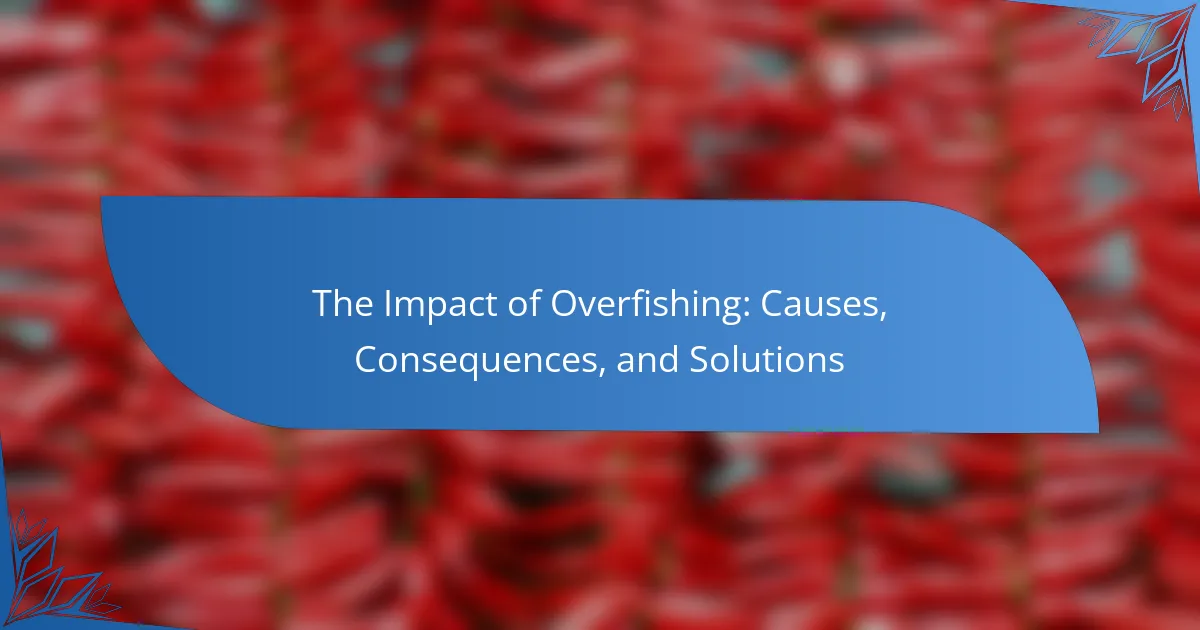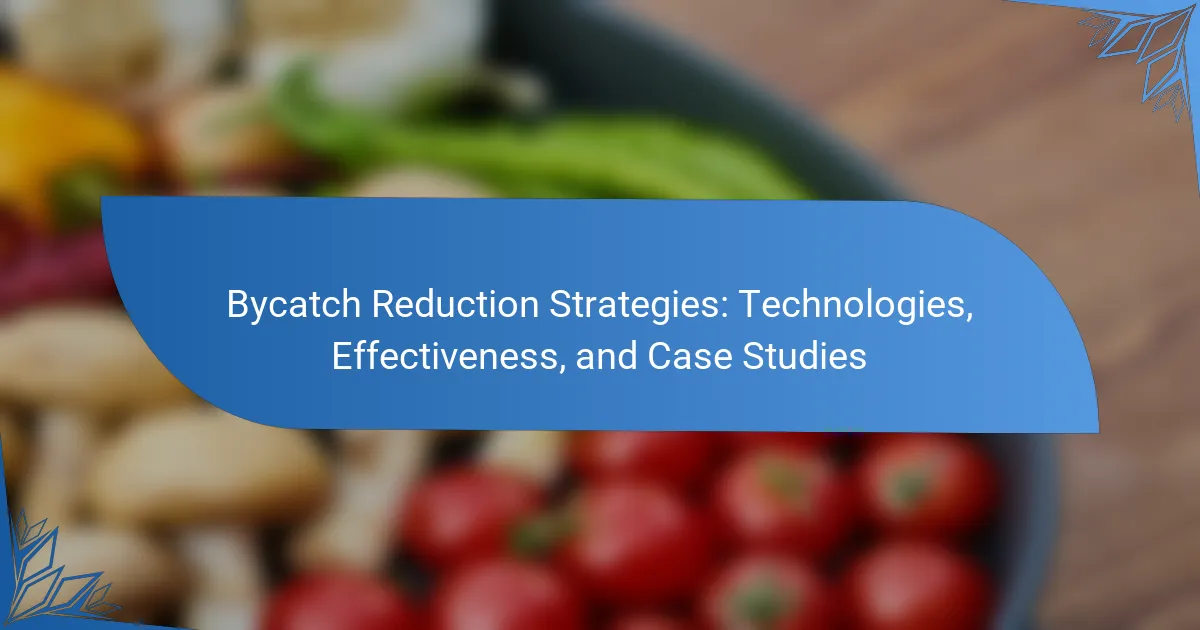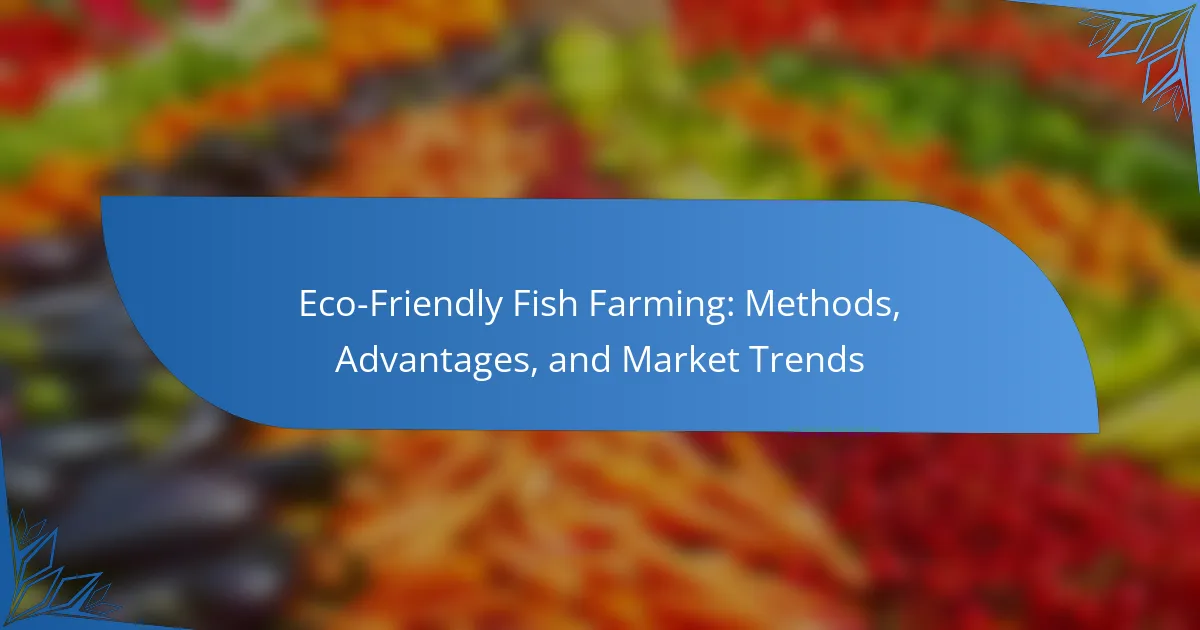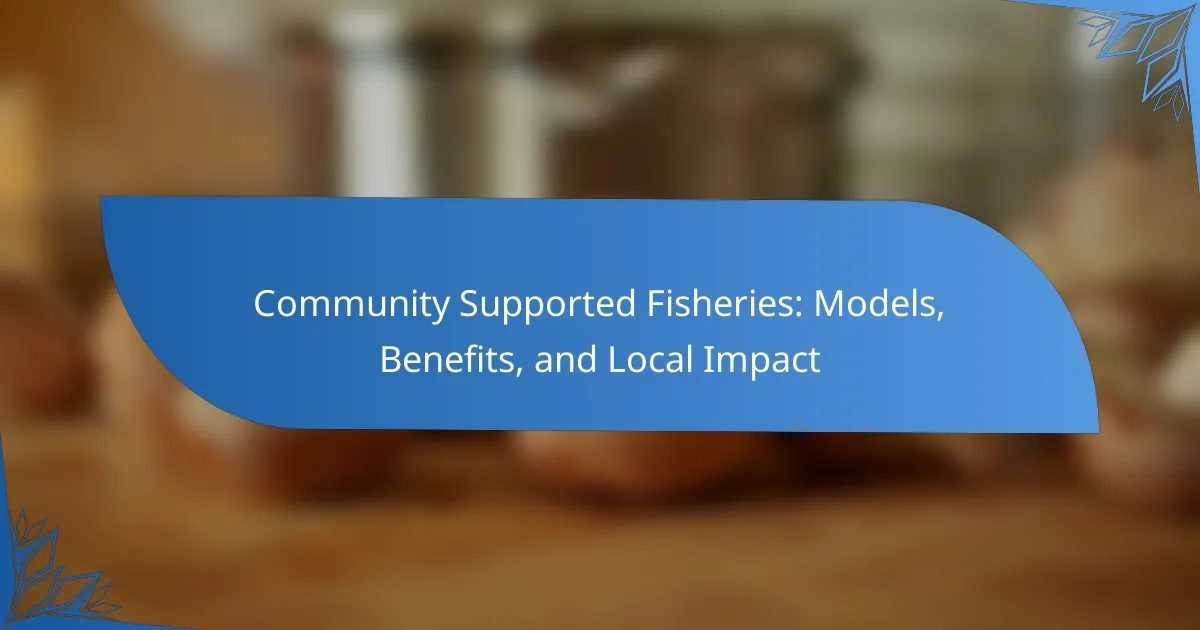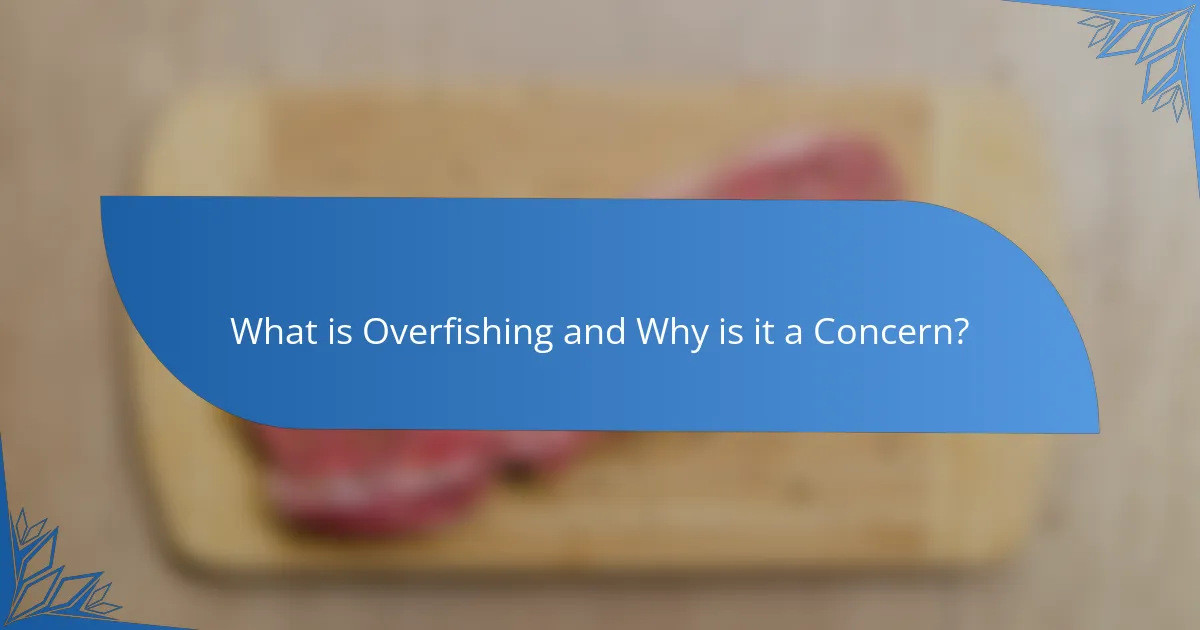
What is Overfishing and Why is it a Concern?
Overfishing is the practice of catching fish at a rate faster than they can reproduce. This leads to a decline in fish populations and disrupts marine ecosystems. Overfishing is a concern because it threatens biodiversity and the health of ocean habitats. According to the Food and Agriculture Organization, around 34% of fish stocks are overfished. This unsustainable practice can result in economic losses for communities dependent on fishing. Additionally, overfishing can lead to the collapse of entire fish species, impacting food security. The long-term effects include diminished fish stocks and altered marine environments.
How is overfishing defined in marine ecology?
Overfishing is defined in marine ecology as the extraction of fish populations at a rate that exceeds their natural reproduction. This leads to a decline in fish stocks and disrupts marine ecosystems. According to the Food and Agriculture Organization, approximately 34% of global fish stocks are overfished. Overfishing can result in the depletion of species and affect biodiversity. It also impacts the livelihoods of communities that depend on fishing. Sustainable fishing practices are essential to prevent overfishing and ensure marine resource availability.
What are the key indicators of overfishing?
Key indicators of overfishing include declining fish populations and reduced catch sizes. Overfishing leads to fewer fish available for capture, which is evident in commercial fisheries reporting lower yields. Another indicator is the increase in bycatch, where non-target species are caught unintentionally. This disrupts marine ecosystems and affects biodiversity. Additionally, changes in the age and size distribution of fish populations signal overfishing. Younger and smaller fish dominate catches, indicating that mature breeding stocks are depleted. Lastly, increased fishing effort, such as more boats and advanced technology, often correlates with overfishing trends. These indicators collectively reflect the unsustainable practices affecting marine life.
How does overfishing differ from sustainable fishing practices?
Overfishing involves catching fish at a rate faster than they can reproduce. This leads to declining fish populations and ecosystem imbalances. Sustainable fishing practices, on the other hand, ensure that fish are harvested at a rate that allows for population recovery and ecological balance. Sustainable methods include setting catch limits and protecting habitats. According to the Food and Agriculture Organization, over 34% of global fish stocks are overfished, while sustainable practices support long-term fishery health and biodiversity. Thus, the key difference lies in the impact on fish populations and ecosystems.
What are the primary causes of overfishing?
Overfishing is primarily caused by excessive fishing practices, lack of regulation, and high consumer demand. Excessive fishing practices include using advanced technology that increases catch rates. Lack of regulation allows fish stocks to be depleted without sustainable limits. High consumer demand drives fishing industries to prioritize short-term profits over long-term sustainability. According to the Food and Agriculture Organization, about 34% of global fish stocks are overfished. Unsustainable fishing methods, such as trawling, also contribute to habitat destruction. Additionally, illegal fishing exacerbates the problem by bypassing regulations. These factors combined lead to significant declines in fish populations worldwide.
How do fishing technologies contribute to overfishing?
Fishing technologies contribute to overfishing by enhancing efficiency and catch rates. Advanced gear, such as trawlers and sonar systems, allows fishermen to locate and capture fish more effectively. These technologies often target specific species, leading to depletion of those populations. According to the Food and Agriculture Organization, 34% of global fish stocks are overfished. This overexploitation occurs because modern equipment can harvest fish faster than they can reproduce. Consequently, fishing pressure increases on vulnerable species, disrupting marine ecosystems.
What role does consumer demand play in driving overfishing?
Consumer demand significantly drives overfishing by creating a market for fish products. High consumer preference for seafood leads to increased fishing efforts. This demand encourages fisheries to catch more fish than sustainable levels allow. Overfishing occurs when fish populations are depleted faster than they can reproduce. For instance, the Food and Agriculture Organization (FAO) reports that around 34% of global fish stocks are overfished. Additionally, consumer trends for specific species exacerbate this problem. When popular species are targeted, it can lead to the decline of those populations. Thus, consumer choices directly influence fishing practices and the health of marine ecosystems.
What are the environmental impacts of overfishing?
Overfishing significantly disrupts marine ecosystems. It leads to the depletion of fish populations, affecting biodiversity. When key species are overfished, the balance of marine food webs is altered. This can result in the overpopulation of certain species, such as jellyfish. Additionally, overfishing can damage habitats, including coral reefs and ocean floors. The loss of fish also impacts other marine life that relies on them for food. According to the Food and Agriculture Organization, about 34% of global fish stocks are overfished. This unsustainable practice threatens the long-term health of oceans and the livelihoods of communities dependent on fishing.
How does overfishing affect marine biodiversity?
Overfishing significantly reduces marine biodiversity. It leads to the depletion of fish populations, disrupting food webs. As certain species decline, others may overpopulate, causing imbalances. This can result in the loss of important species, including predators and prey. Overfishing also affects habitats, such as coral reefs and seagrass beds. These ecosystems are vital for many marine organisms. Research indicates that overfishing has contributed to a 90% decline in large predatory fish populations since the mid-20th century. The loss of biodiversity can hinder ecosystem resilience and recovery.
What are the consequences of overfishing on ocean ecosystems?
Overfishing leads to severe consequences for ocean ecosystems. It results in the depletion of fish populations, disrupting the food chain. As key species decline, predator-prey relationships are altered. This imbalance can cause certain species to overpopulate, leading to further ecological disruption. Overfishing also damages habitats, such as coral reefs and sea beds, through destructive fishing practices. Additionally, the loss of biodiversity weakens ecosystem resilience. This makes ecosystems more vulnerable to changes and stresses, such as climate change. Studies show that sustainable fishing practices can mitigate these negative effects.
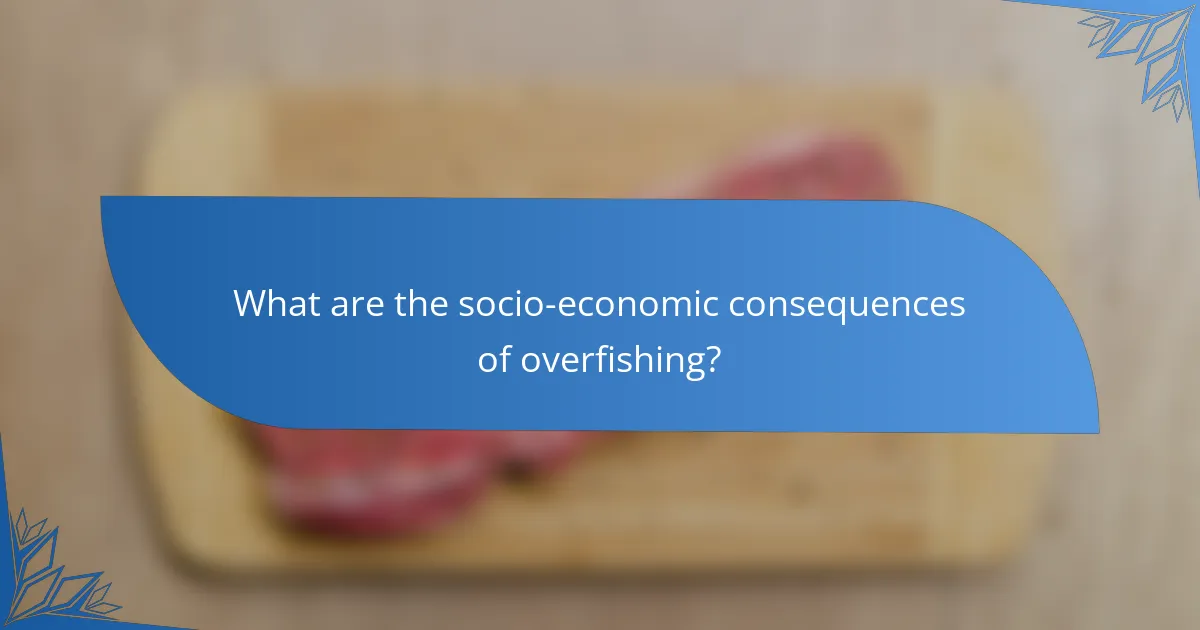
What are the socio-economic consequences of overfishing?
Overfishing leads to significant socio-economic consequences, impacting communities reliant on fishery resources. It decreases fish populations, which threatens food security for millions globally. Economic activities linked to fishing, such as processing and trade, suffer from reduced catch volumes. Job losses in fishing industries can result from dwindling fish stocks. Coastal communities often face increased poverty as livelihoods deteriorate. Additionally, overfishing disrupts local economies by increasing fish prices due to scarcity. The decline in fish availability can also affect cultural practices tied to fishing traditions. According to the Food and Agriculture Organization, over 34% of fish stocks are overfished, highlighting the urgency of addressing these socio-economic impacts.
How does overfishing impact local fishing communities?
Overfishing severely impacts local fishing communities by depleting fish stocks essential for their livelihoods. This depletion reduces the availability of fish, leading to lower catches for local fishermen. Consequently, income levels in these communities decline, affecting their economic stability. Additionally, overfishing disrupts local ecosystems, which can result in the loss of biodiversity. The decline in fish populations can also lead to increased competition among fishermen, exacerbating tensions within the community. Studies show that communities reliant on fishing may face food insecurity as fish become scarcer. This situation forces some fishermen to seek alternative employment, often leading to urban migration. Overall, overfishing undermines the social and economic fabric of local fishing communities.
What are the economic repercussions for fishermen and their livelihoods?
Overfishing leads to significant economic repercussions for fishermen and their livelihoods. Reduced fish stocks result in lower catch volumes. This decline directly impacts income levels for fishing communities. Fishermen face increased competition for dwindling resources. Many may struggle to cover operational costs, including fuel and maintenance. Job losses can occur as businesses scale back or close. Local economies suffer due to decreased spending and reduced market activity. According to a study by the Food and Agriculture Organization, global fish stocks are overfished, affecting millions of livelihoods.
How does overfishing affect food security globally?
Overfishing significantly undermines global food security. It depletes fish populations, which are a primary protein source for billions of people. According to the Food and Agriculture Organization (FAO), nearly 3 billion people rely on fish as a key part of their diet. When fish stocks decline, communities face increased hunger and malnutrition. Overfishing also disrupts marine ecosystems, affecting species diversity and the health of ocean environments. This disruption can lead to the collapse of local fisheries, further exacerbating food shortages. As fish become scarcer, prices rise, making them less accessible to vulnerable populations. The consequences of overfishing extend beyond immediate food availability, threatening livelihoods and economic stability in fishing communities worldwide.
What measures can be taken to mitigate overfishing?
Implementing sustainable fishing practices is essential to mitigate overfishing. This includes establishing catch limits based on scientific assessments. These limits ensure fish populations remain healthy and can reproduce effectively. Another measure is the creation of marine protected areas. These areas allow ecosystems to recover by restricting fishing activities. Promoting aquaculture can also alleviate pressure on wild fish stocks. Aquaculture provides an alternative source of seafood without depleting natural resources. Educating consumers about sustainable seafood choices encourages responsible purchasing. This can shift demand towards sustainably sourced products. Lastly, enforcing regulations against illegal fishing is crucial. Illegal fishing undermines conservation efforts and depletes fish stocks further.
How effective are fishing quotas in controlling overfishing?
Fishing quotas are effective in controlling overfishing. They limit the amount of fish that can be caught during a specific period. This regulation helps maintain fish populations at sustainable levels. Studies show that regions with strict quotas have seen fish stocks recover. For example, the North Atlantic cod fishery improved after implementing quotas. Quotas also encourage responsible fishing practices. However, enforcement and compliance are critical for their success. Ineffective monitoring can lead to illegal catches, undermining the quotas’ purpose. Overall, when properly enforced, fishing quotas are a valuable tool in combating overfishing.
What role do marine protected areas play in sustainable fishing?
Marine protected areas (MPAs) play a crucial role in sustainable fishing by conserving marine biodiversity and replenishing fish stocks. MPAs restrict or regulate human activities, allowing ecosystems to recover and thrive. This recovery leads to increased fish populations, which can spill over into surrounding fishing areas. Studies show that fish biomass can be significantly higher within MPAs compared to unprotected areas. For example, a review of 124 studies found that MPAs increased fish populations by an average of 446%. By providing safe havens for fish, MPAs enhance the resilience of marine ecosystems. This ultimately supports the long-term viability of fisheries and promotes sustainable fishing practices.
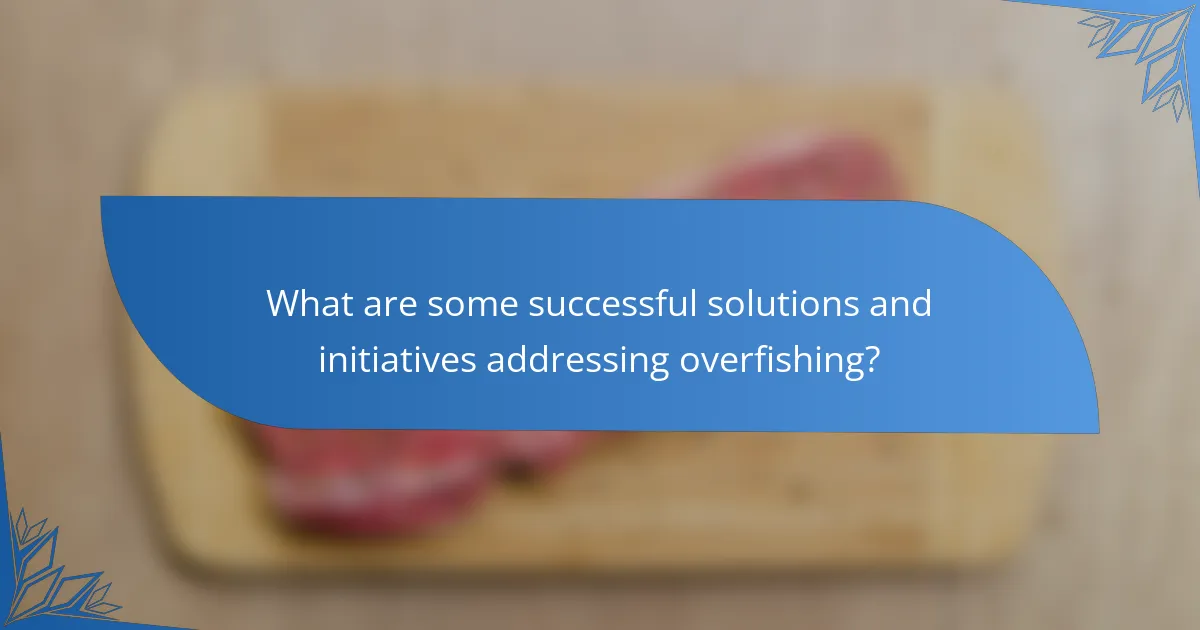
What are some successful solutions and initiatives addressing overfishing?
Successful solutions and initiatives addressing overfishing include the implementation of catch limits and marine protected areas. Catch limits regulate the number of fish that can be harvested, ensuring sustainable populations. For example, the U.S. has established catch shares in fisheries, leading to a 30% increase in fish stocks since 2000. Marine protected areas restrict fishing activities in specific regions, allowing ecosystems to recover. The Great Barrier Reef Marine Park in Australia has seen significant biodiversity improvements due to such protections. Community-based management empowers local fishers to regulate their resources effectively. This approach has been successful in places like the Philippines, where local initiatives have restored fish populations. International agreements, such as the United Nations Fish Stocks Agreement, promote cooperation among countries to manage shared fish stocks sustainably. These initiatives demonstrate measurable success in reversing the trends of overfishing globally.
What innovative practices are being adopted to promote sustainable fishing?
Innovative practices promoting sustainable fishing include the use of technology, community-based management, and aquaculture. Technology such as satellite monitoring enhances tracking of fishing activities. This helps prevent illegal fishing and overfishing. Community-based management involves local fishermen in decision-making. Their insights lead to more effective conservation strategies. Aquaculture provides an alternative source of seafood. It reduces pressure on wild fish populations. According to the Food and Agriculture Organization, sustainable aquaculture can meet the growing seafood demand without harming marine ecosystems. These practices collectively contribute to healthier fish stocks and ecosystems.
How can technology aid in monitoring fish populations?
Technology aids in monitoring fish populations through various methods. Remote sensing technology allows researchers to gather data from large aquatic areas. Acoustic monitoring systems track fish movements and behaviors in real-time. Drones and underwater robots can survey hard-to-reach habitats. Genetic sampling technologies provide insights into population genetics and biodiversity. These methods enhance data accuracy and reduce human error. For example, the use of eDNA (environmental DNA) can detect fish presence even when they are not visible. Studies show that these technologies improve management strategies and conservation efforts.
What community-led initiatives have proven successful in combating overfishing?
Community-led initiatives such as co-management fisheries and community marine reserves have proven successful in combating overfishing. Co-management fisheries involve local communities collaborating with government agencies to manage fish stocks sustainably. This approach has been effective in places like the Philippines, where local fishers have reduced overfishing through shared responsibilities.
Community marine reserves, established in regions like the Caribbean, restrict fishing in designated areas to allow fish populations to recover. Studies show that these reserves can increase fish biomass by over 400% within a few years.
Additionally, education and awareness programs empower local communities to adopt sustainable fishing practices. In Madagascar, community-led awareness campaigns have significantly decreased illegal fishing activities. These initiatives demonstrate that local involvement and management can lead to sustainable fisheries and healthier marine ecosystems.
What can individuals do to help reduce overfishing?
Individuals can help reduce overfishing by making informed seafood choices. They should choose sustainably sourced seafood, which supports responsible fishing practices. Research shows that over 30% of global fish stocks are overfished. By avoiding species that are overexploited, individuals can contribute to the recovery of fish populations.
Additionally, reducing seafood consumption can lessen demand on fish stocks. Supporting local fisheries that practice sustainable methods also helps maintain healthy ecosystems. Educating others about the impacts of overfishing raises awareness and promotes conservation efforts. Lastly, individuals can advocate for policies that protect marine environments and regulate fishing practices.
How can consumers make informed choices about seafood consumption?
Consumers can make informed choices about seafood consumption by researching sustainability ratings. Sustainable seafood guides, like the Monterey Bay Seafood Watch, provide information on eco-friendly options. Consumers should look for certifications such as the Marine Stewardship Council (MSC) label. These labels indicate that the seafood is sourced from well-managed fisheries. Additionally, consumers can inquire about the seafood’s origin and fishing practices at restaurants and markets. Awareness of seasonal seafood availability can also guide better choices. Studies show that informed consumers can help reduce overfishing by selecting sustainable options.
What are some practical steps individuals can take to support sustainable fishing practices?
Individuals can support sustainable fishing practices by choosing seafood from certified sustainable sources. Look for labels like the Marine Stewardship Council (MSC) or the Aquaculture Stewardship Council (ASC). These certifications indicate that the seafood is harvested responsibly. Additionally, individuals should educate themselves about local fish species and their conservation status. Avoid purchasing overfished species to help reduce demand. Participating in local clean-up events can also benefit aquatic ecosystems. Supporting policies that promote sustainable fishing practices is crucial. Engaging in advocacy for marine protection can lead to long-term improvements. Finally, reducing overall seafood consumption can lessen the pressure on fish populations.
The main entity of this article is overfishing, defined as the practice of catching fish at a rate that exceeds their natural reproduction, leading to declines in fish populations and disruptions in marine ecosystems. The article outlines the causes of overfishing, including excessive fishing practices, lack of regulation, and high consumer demand, and highlights its significant socio-economic and environmental consequences, such as food insecurity and loss of biodiversity. Additionally, it explores effective solutions and initiatives, including sustainable fishing practices, fishing quotas, and community-led management efforts, aimed at mitigating the impacts of overfishing and promoting the health of marine ecosystems.
